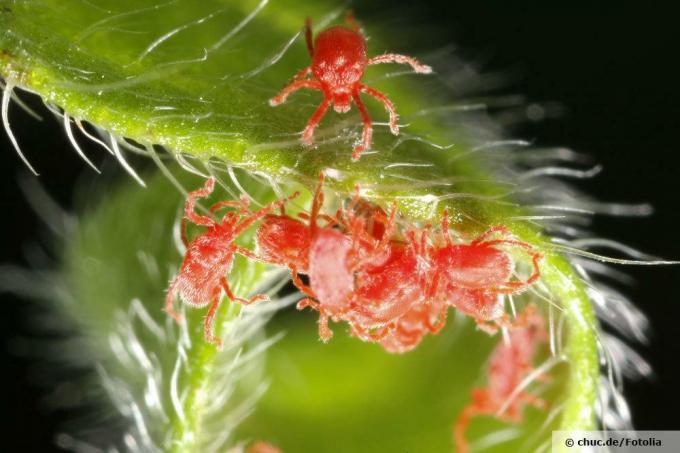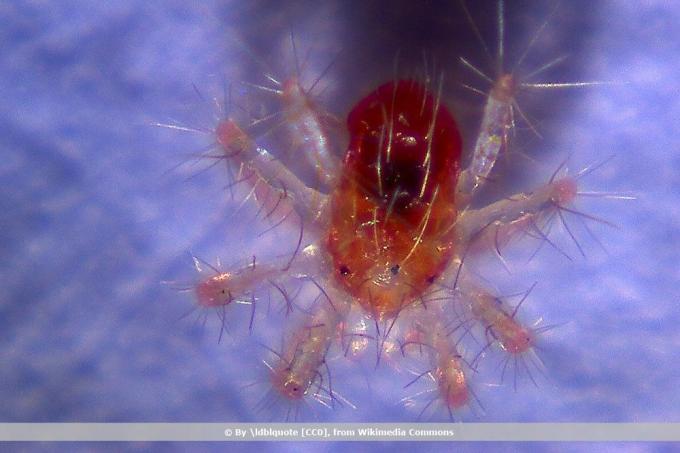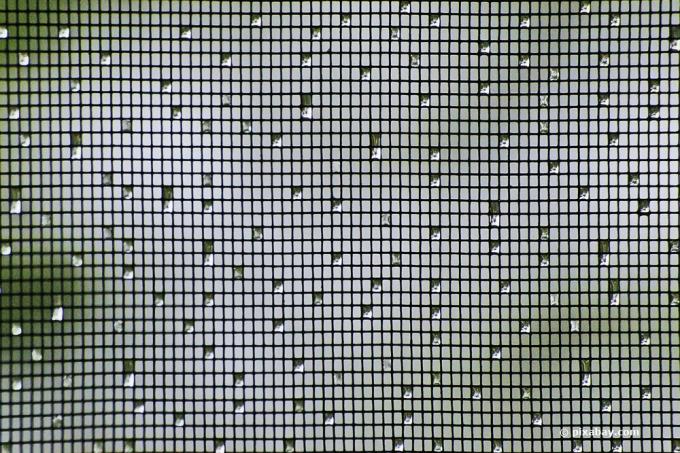
table of contents
- Red velvet mite
- Recognize and distinguish mites
- Red velvet mite
- Fruit tree spider mite
- Fighting red velvet mite: 5 tips
- 1. Insect screens
- 2. Closed windows and doors
- 3. water
- 4. Thick-walled glass
- 5. Last resort vermin spray
Trombidium holosericeum spreads like a swarm in numerous German gardens during the summer months. The easily visible red velvet mites are often in close proximity to humans and are viewed with disgust by many. No wonder the arachnids, which are between one and four millimeters in size, crawl around on the terrace or on the garden furniture and even move into the living room. If an infestation occurs by the actual beneficial insects, many people and gardeners are on the lookout for suitable methods to get rid of them again. When fighting the red velvet mite, it is important to check whether it is this species or another species of mite. There are red, small arachnids in many families.
Red velvet mite
Caution: risk of confusion!
Yes, the red velvet mite can be confused with another, much better known mite: the red spider. Also known as the fruit tree spider mite, Panonychus ulmi is one of the largest pests in German and Central European gardens. They preferentially attack fruit trees and vines and can cause immense damage that can stunt a proud apple tree. Fruit tree spider mites are combated in a completely different way than red velvet mites. Because of this, you should know the differences between the two mites:
Recognize and distinguish mites
Red velvet mite
- Size: 1 to 4 mm
- densely hairy
- scarlet
- Body looks like velvet
- significantly enlarged abdomen
- long front legs
- small eyes
- Jaw claws are reminiscent of scissors
- soft-skinned
- prefer dry and warm habitats
- mostly populate forest edges, masonry and dry lawns
- in the garden there are mostly terraces and walls

The red velvet mite is one Beneficial organism, because he has chosen neither humans, animals nor plants as a target. As larvae and in the adult stage, the mites eat insects and other arachnids, above all butterflies, some beetles such as the black weevil and many others. The biggest advantage of the mites: They suck out the insect eggs of numerous pests, which is ideal for containing this population.
Fruit tree spider mite
- Size: 0.5-0.6mm
- carmine
- individual clearly protruding bristles on the back of the female
- significantly smaller head
- the body shape is plump, not so pronounced
- can be found on fruit trees, vines and other woody plants

Most of the time, gardeners don't work directly on that Pests attentive, but rather on the damage caused after the infestation:
- Leaves show light spots from spring onwards
- these can be speckled
- Leaves turn more and more a sickly yellow shade
- Mites, larvae and eggs are mainly found on the underside of the leaves
- cobwebs-like structures can also be seen
- Leaves dry out more and more
- gradually fall off
As you can see, you always need to check beforehand which mite it really is. Since, unlike the fruit tree spider mite, you don't need to remove red velvet mites, this comparison is important. Since the velvet mite is not interested in plants, but keeps the overpopulation caused by pests in check, it does not pose a threat.
tip: Another possible risk of confusion is with Tarsonemus pallidus fragariae, the strawberry soft skin mite. This is between half a millimeter and a millimeter long, a little more orange in terms of color and mainly affects strawberry plants (bot. Fragaria), but also other plants in the garden.
Fighting red velvet mite: 5 tips
As you can see from the way the red velvet mite lives, this arachnid is a natural one Beneficial organism. Even if these occur in large numbers, they pose no danger to humans, animals or plants and even help to destroy pests. Nevertheless, it can happen that the red crawfish colonize your living space or disrupt everyday life. Below are 5 ways to keep the red velvet mite away.
1. Insect screens
An effective way to keep the red velvet mite out of your home is to use insect screens. You can choose standard models here, because these are sufficient due to the size of the mites. Trombidium holosericeum can only spread in their living spaces if the arachnids get into them. With insect screens on doors and windows, the mites cannot find a way into your house and stay outside. You should particularly think about using the grilles on the following floors:
- basement, cellar
- ground floor
- Mezzanine floor

An adjoining terrace in particular is ideal for the arachnids to get into your house, as they like to stay there due to the dryness and higher temperatures. One advantage of the insect screens is that they can be ventilated. Although these do not work in the garden, they do ensure a good night's sleep.
2. Closed windows and doors
As an alternative to the insect screens, you can simply leave your doors and windows closed for a longer period of time, especially overnight. Since the red velvet mite is looking for a warm place to stay at night, open doors and windows are almost an invitation. You should therefore keep them closed especially at these times of the day. You should also use this tip end of the summer because the mites can nest over the winter.
3. water
Since the mites are arachnids that prefer drought, it is not surprising that water can be used effectively against them. However, there is no point in spraying the animals directly, as they should not necessarily be killed because of their benefits, especially if you are the proud owner of a garden. Moisture in the garden helps to deprive the velvet mites of any of the above-mentioned habitats, which would otherwise be completely populated within a few days. The following points will help you drive away the animals with water:
- Spray stone surfaces regularly with a garden hose
- choose a high level
- especially natural stones have to be hosed down
- also splash stone walls
- Water more frequently in periods of intense drought
- race water regularly
- Wash garden furniture regularly
It is normal that an infestation by the red velvet mite is less common in humid areas of Germany. This is what makes the use of water so effective. However, you should not use this method if the higher humidity would cause problems from other plants or even pests.
4. Thick-walled glass
With many insects and arachnids, it helps if you build a glass barrier in your garden. This does not mean a glass fence, but thick-walled bottles or large glasses. The surface is uncomfortable for the mites and for this reason they refrain from moving over it. You can take advantage of this by framing your terrace or a wall with glass, for example. These are embedded in the ground, fixed and thus represent a barrier for the mites. Depending on the severity of the infestation, this barrier can work wonders.
5. Last resort vermin spray
If none of the tips mentioned so far can be implemented or really work for you, you can resort to the chemical club. Remember that the main help with the mites is sprays, which create an odor barrier that the animals do not want to cross. Sprays that kill the arachnid, on the other hand, don't really help the mites. However, these biocidal products have some disadvantages and must be used with particular care due to the following points, because you do not want to poison yourself:
- are extremely flammable
- can seriously contaminate water sources in the garden
- particularly toxic to aquatic organisms
- irritates the mucous membranes and skin
- can crack the skin if used incorrectly
These are just a few of the disadvantages these products have. When using it, it is important to keep enough space and it is best not to use it in your own house or apartment. If you have important pollinator insects in your garden, you should stay away from the biocides. Only use this if the infestation has spread so much that you no longer feel comfortable in your everyday life. The advantage of the biocides: They are usually with a Long-term effect which lasts between six weeks and six months.

If the arachnids are really too dissolute in their population and populate the entire house or terrace, you should turn to an exterminator. In any case, be careful about crushing or wiping the animals away. The mites leave red stains, which can mainly be seen on clothing and surfaces. So be careful not to damage these as the stains will be difficult to remove.
